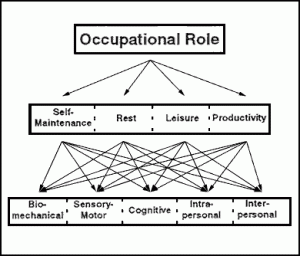CONSTRUCT 4: OCCUPATIONAL PERFORMANCE COMPONENTS
Accomplishment of routines and tasks in the occupational performance areas is predicated on the ability to sustain efficient physical, psychological and social function. This aspect of the model is conceptualised as forming both the component attributes of the performer as well as the components of occupational tasks. For example, there are physical, sensory-motor, cognitive, and psychosocial dimensions to any task performed. These dimensions mirror and prompt a person’s various physical, sensorymotor, cognitive and psychosocial operations that are used to engage in task performance. Observation and analysis of occupational performance components can either focus on the task and sub-task components of performance (task demands analysis) or the person components of performance (behavioural task April, 1997, Monograph 1 10 analysis) and the relationship between the two. Occupational performance components are broadly classified into five component areas: biomechanical, sensory motor, cognitive, intrapersonal and interpersonal (Fig. 5).
Figure 5: Components of Occupational Performance and their relationship to other constructs
Biomechanical Component: From the perspective of the performer this component refers to the operation and interaction of and between physical structures of the body during task performance. This can include range of motion, muscle strength, grasp, muscular and cardiovascular endurance, circulation, elimination of body waste. From the perspective of the task being done this component refers to the biomechanical attributes of the task; for example, size, weight, dimension and location of objects.
Sensory-Motor component: From the perspective of the performer this component refers to the operation and interaction of and between sensory input and motor responses of the body during task performance. This can include regulation of muscle activity, generation of appropriate motor responses, registration of sensory stimuli and coordination. From the perspective of the task this component refers to the sensory aspects of the task. For example, gravity, colour, texture, temperature, weight, movement, sound, smell and taste.
Cognitive Component: From the perspective of the performer this component refers to the operation and interaction of and between mental processes used during task performance. This can include thinking, perceiving, recognising, remembering, judging, learning, knowing, attending and problem solving. From the perspective of the task this component refers to the cognitive dimensions of the task. These are usually determined by the symbolic & operational complexity of the task.
Intrapersonal Component: From the perspective of the performer this component refers to the operation and interaction of and between internal psychological processes used during task performance. This can include emotions, self-esteem, mood, affect, rationality and defense mechanisms. From the perspective of the task this component refers to the intrapersonal attributes that can be stimulated by the task and are required for effective task performance such as valuing, satisfaction and motivation.
Interpersonal Component: From the perspective of the performer this component refers to the continuing and changing interaction between a person and others during task performance that contributes to the development of the individual as a participant in society. This can include interaction among individuals in relationships such as partnerships, families, communities and organisations both formal and informal. Interactive examples include sharing, cooperation, empathy, verbal and nonverbal communication. From the perspective of the task this component refers to the nature and degree of interpersonal interaction required for effective task performance. The impact of components on occupational Occupational Performance Model (Australia) 11 performance is the result of a complex network of interactions involving interdependent relationships between the components themselves as well as between each component and other constructs within the model. The capacity of the components to influence each other is illustrated by the dotted lines contained within this level of the Model (Fig. 5). The arrows between levels in the Model (Fig.5) illustrate the interaction between the components and other levels of the model.
Analysis of Occupational Performance: Components of Occupational Performance
There are many analyses occupational therapists use to determine the efficacy of occupational performance at this level of the model. For example, goniometry can be used to analyse biomechanical operations of range of motion (Trombly & Scott, 1989); recall of digit-span can be used to analyse short-term memory operations (Duchek, 1991); maintenance of body position on a balance board is an example of one sensorymotor operation (Fisher, Murray & Bundy, 1991); measures of social interaction can be used to analyse interpersonal operations (Mosey, 1986); and loneliness or depression inventories are described as measures of intrapersonal operations (Borg & Bruce, 1991). However, Leont’ev (1978) reminds us that it is impossible to analyse many of these operations independent from the context in which they are embedded. Each operation has an interaction with other operations. Therefore, analysis at this level requires:
- identification of component operations that support task and routine performance in the everyday world.
- the effect of one component on other component operations be considered.
- consideration of the task demands and the ‘fit’ between these and the component operations of the performer.

